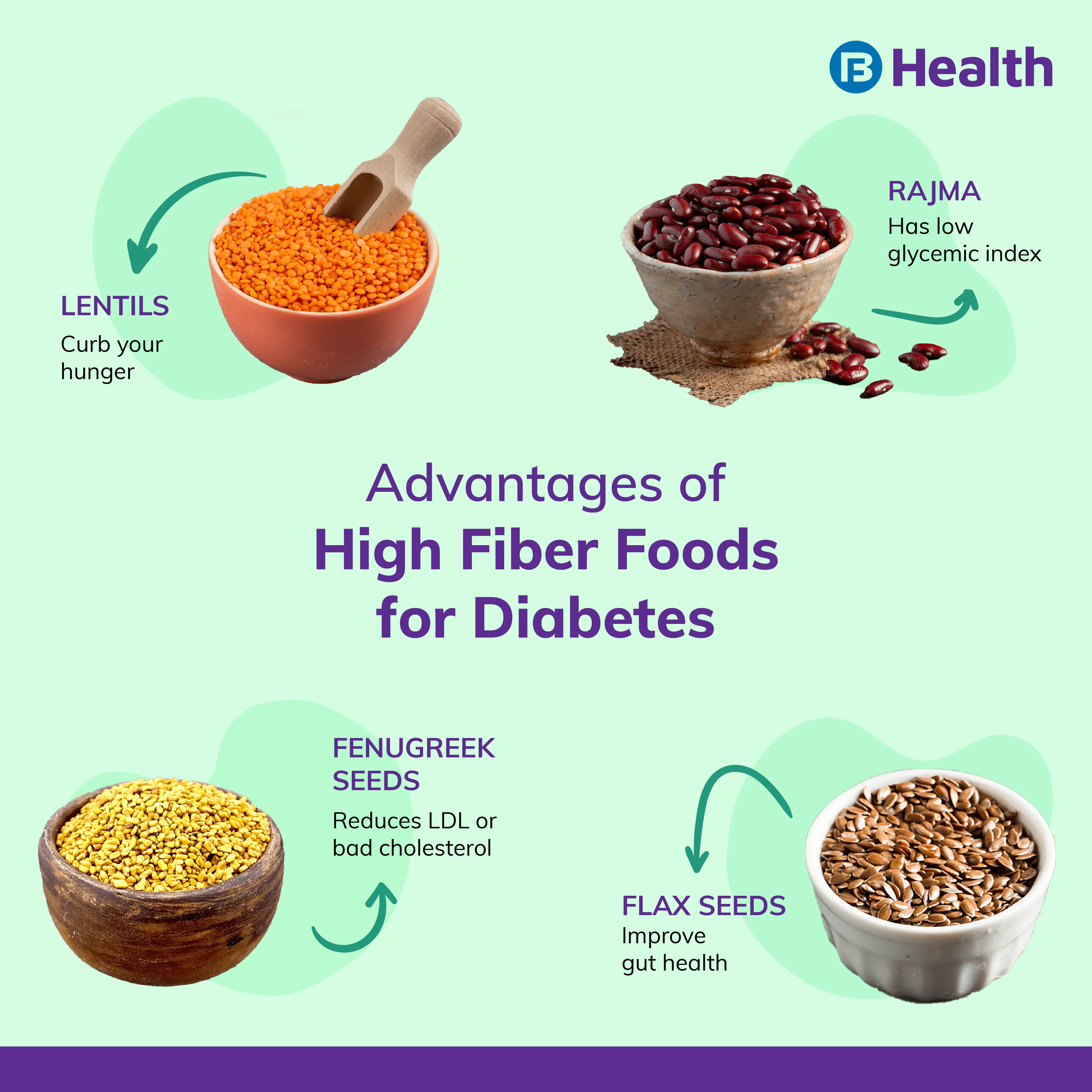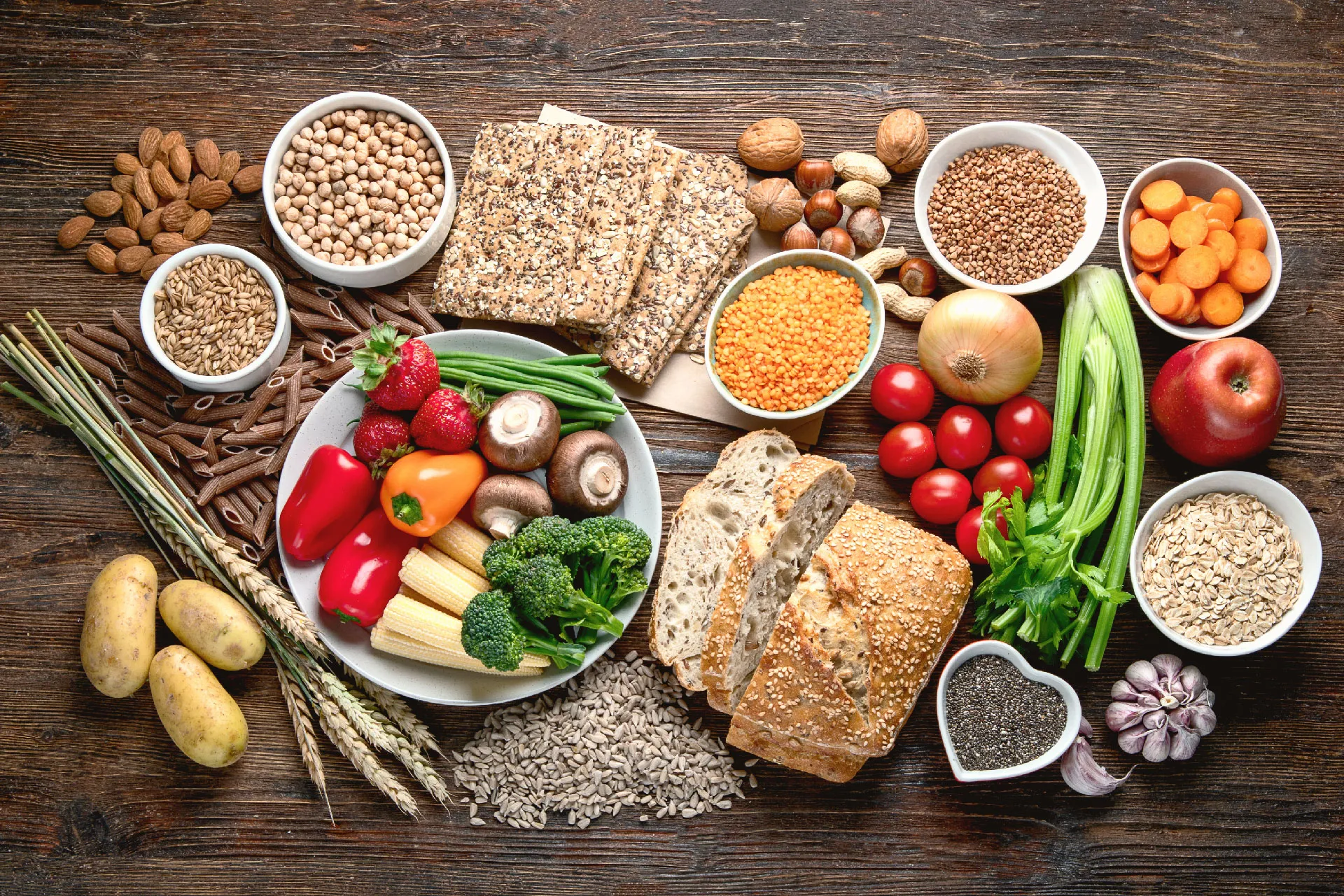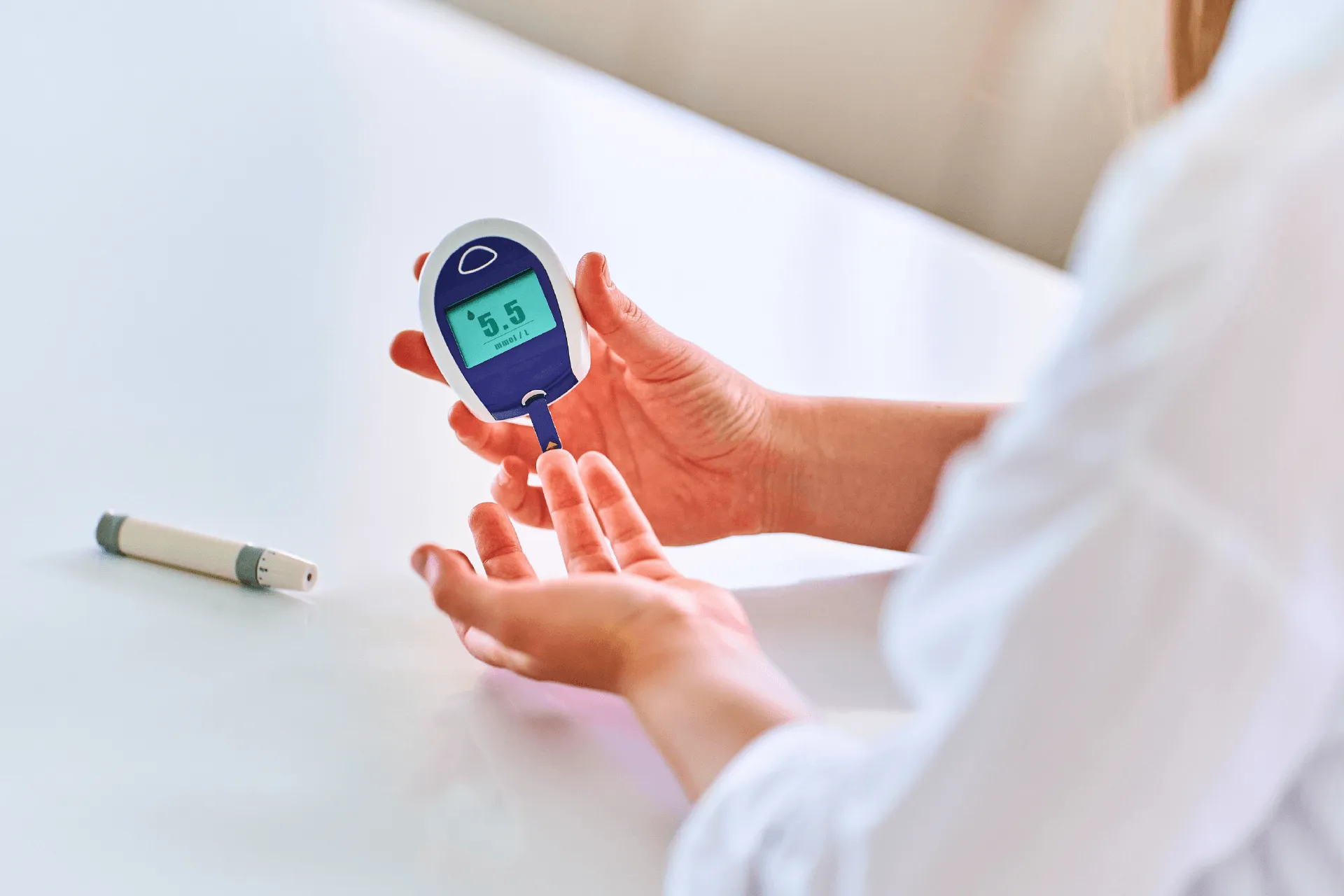Diabetes | 9 min read
High Fiber Foods for Diabetics to Keep Blood Sugar Levels in Control
Medically reviewed by
Table of Content
Key Takeaways
- Lentils are one of the high-fiber foods for diabetics
- Beans have soluble fiber that improve gut health
- Fenugreek seeds help lower LDL or bad cholesterol
Fiber forms an essential part of a healthy diet and prevents constipation [1]. It also helps in lowering fasting blood glucose levels and maintaining a healthy weight. The carbohydrates present in high-fiber foods take a longer time to digest than those found in low-fiber foods. This turns out to be a favorable factor in diabetes as slow digestion minimizes spikes in blood sugar levels.
Most commonly referred to as dietary fiber, this category includes plant food parts that cannot be digested or absorbed by the body. Instead, they pass out of the body thereby aiding in proper bowel movement. There are two types of fiber, soluble and insoluble. While soluble fiber dissolves in water to form a gel kind of material, insoluble fiber helps in the movement of roughage.
Daily Fiber Recommendations For Men & Women
Your gender, age, and other characteristics will all affect how much fiber you should consume daily.
Age | Men | Women |
19-30 | 33.6 grams | 28 grams |
31-50 | 30.8 grams | 25.2 grams |
51+ | 28 grams | 22.4 grams |
People who have diabetes and those who are at risk should eat at least the quantity advised for the general public. Your A1C level may go down if you consume more fibre through food or dietary supplements. According to certain research, diets containing 44 to 50 grams of fibre per day can aid in better blood sugar control, according to the ADA [1]. This amount, however, may be challenging for most individuals to swallow owing to taste and gastrointestinal adverse effects.
Everyone may gain from a diet that contains enough fibre consumption, whether or not they have diabetes. For diabetics, a high-fiber diet can be especially advantageous for cholesterol, weight control, and digestive health. A healthcare provider or a registered dietitian nutritionist (RDN) may advise a low-fibre diet for some patients who have specific health conditions.

High Fiber Foods For Diabetics
Test out Oatmeal and Barley
These two whole grains both include a lot of insoluble fibre. Try substituting barley for rice or pasta in your favorite recipes, and use oats instead of bread crumbs to cover baked fish or chicken instead of bread crumbs. Both include the fiber beta-glucan, which enhances insulin action, reduces blood sugar, and aids in removing cholesterol from the digestive system. Cooked barley is considered to be a good source because a serving size of 14 cups has 170 calories, 37 grams of carbs, and more than 7 grams of fibre. Additionally, a serving of rolled oats that is a one-half cup in size has roughly 4 grams of fibre, 150 calories, and 27 grams of carbohydrates.
Take a Berry Bite
Berries are small, delicious, and packed with antioxidants and fibre. While any option will have advantages, raspberries and blackberries are two that are insoluble fibre-rich. Berries contain a wealth of chemicals that are considered to benefit heart health and prevent some forms of cancer. A serving of 1 cup of berries has 60 calories, 3 g of fibre, and 15 g of carbs. Berry desserts sprinkled with shavings of dark chocolate are delicious.
Pick your pears
Pears have the same health advantages, whether green, red, or brown. A big pear has roughly 6 g of fibre, making it a very good source. Adding a little balsamic vinegar to grilled pear slices for a special delight. Serve the slices over salad leaves to start your meal, or consume it as dessert. Plan ahead when including this fruit in your daily meal plan because a big pear has roughly 27 g of carbohydrates and 18 g of natural sugars.
Broccoli Scores Big
A cup of chopped raw broccoli has approximately the same amount of protein and around 2 g of fibre. The same serving size also has only 30 calories and roughly 5 grams of carbs. Additionally, this cruciferous vegetable is a great provider of vitamins C and K. You may also add raw, crisp broccoli to your preferred green salad.
More peas!
These starchy, high-soluble fibre vegetables are an excellent alternative to rice and other grains since they include vitamins A, C, and K. A serving size of two and a third cups of canned, drained green peas has around 3.5 g of fibre, making them a decent source. This is significantly less than rice, which has roughly 11 g of carbs and about 59 calories per serving. Additionally, you acquire roughly 3.8 g of protein in each serving. A 14-cup cooked meal of yellow or green split peas has 9 g fibre, 120 calories, and 21 g carbs, making it an excellent source, according to the USDA. Consider adding peas to your favourite salad for additional nutrients and fibre, or have them alone, sprinkled with some fresh mint and parsley, to help control your carbohydrate consumption while reaping these benefits.
Avocado delight!
Avocados offer both soluble and insoluble fibre as well as heart-healthy omega-3 fatty acids and are excellent mashed into a dip or used as a spread rather as mayo, according to prior studies. An avocado serving size of 1/4 cup has more than 2 g of fibre. 50 calories and 3 g of carbs are also included in the same serving size. Additionally, it contains almost 5 g of fat, so keep in mind that a little goes a long way. Choose an avocado slice on your favourite sandwich in place of cheese, which includes less-healthy saturated fat, and a tablespoon of mashed avocado in place of 1 tablespoon of butter while baking.
Here is a list of 5 high-fiber foods for diabetics that may provide umpteen benefits when included in the daily diet.
Additional read: Diet for DiabeticsMake Lentils Your Daily Companion
Lentils belong to the category of legumes and are rich in proteins and fiber. Of the total carbohydrate content present in lentils, about 40% is soluble fiber. This soluble fiber helps to stabilize your blood sugar levels. The complex carbs present in lentils help in controlling blood glucose and cholesterol levels. Including these fiber foods for diabetes in your diet may curb your hunger issues as well. You may use lentils in the form of soup, porridge, curries or even in salads.
Have Beans by Tossing Them in Your Favorite Salad or Curry
Like lentils, beans are packed with the goodness of fiber and proteins. In 1/3 cup of cooked red kidney beans, there is 5g of protein, 4g of fiber and 12g of carbs and a total of 73 calories. A low glycemic index value is what makes beans one of the good fiber foods for diabetes as these can keep your blood sugar well under control. Beans have soluble fiber content that helps in improving the gut health [2]. Whip out delicious gravies out of beans or include them in your salads!
Top Your Smoothies with Flax Seeds
Another food that provides high fiber for diabetics is flax seeds. These are packed with lignan, which is an insoluble fiber and a powerful antioxidant. This helps to keep your blood glucose levels in check and improves gut health. Consuming them daily enhances insulin sensitivity and minimizes the risk of stroke and heart ailments. Use it in powdered form or top it on your salads, smoothies or chillas. However, it is better to consult with a doctor to check if eating flax seeds regularly can interfere with your diabetes medications. If you protect yourself from diabetes you can avail diabetes health insurance.

Indulge in Whole Grains to Control Spikes in Blood Sugar
Whole grains are known to provide the best fiber for diabetics. Be it brown bread or even brown rice, consuming these fiber-rich, whole grain foods results in slowing the digestion process. As a result, it prevents your blood sugar from increasing thereby making them an important fiber for diabetics. Whole grains like oats and barley also keep your weight under control apart from reducing the LDL or bad cholesterol level in the blood.
Additional read: What is Good CholesterolManage Diabetes by Having Fenugreek Seeds Daily
Be it in the form of seeds or leaves, methi or fenugreek is good for managing diabetes. As these are rich in soluble fiber, the digestion process slows down thereby helps in lowering the blood glucose levels. Fenugreek also reduces the LDL levels in your blood [3]. Either grind it and consume it with food in the form or chillas or soak it overnight and drink methi water the next morning on an empty stomach.
Know Why Fiber is Important for Diabetes
Fiber is a key component of meal planning for diabetics since it lowers the risk of cardiovascular disease development. Fibre can lower the risk of colon cancer and cardio-metabolic disorders like heart disease, obesity, and insulin resistance.
Fibre assists by lowering blood pressure and cholesterol levels and can also aid in improved weight management. In comparison to other meal alternatives, high-fiber foods for diabetes have a lower glycemic index (GI), which makes them satisfying and can help you control your hunger. They also have less impact on blood sugar levels.
Only plant-based meals contain fiber, and high-fiber foods often have minimal fat and calorie content. But be aware that adding lipids to vegetables, such as cheese or butter, can raise their fat and calorie content. Use low-sodium broth or herb spices to flavor steamed vegetables instead of butter or oil to maintain a heart-healthy diet.
Chewing high-fiber foods may take longer, giving our bodies more time to detect fullness and reducing overeating. Additionally, fiber permits water to stay in our intestines and stomach, which might prolong our feeling of fullness.
Apart from the above-mentioned foods, there are many other fiber-rich foods for diabetics. Some of these include green leafy vegetables, pumpkin and fruits like guavas, cherries and watermelons. However, it is best to follow an active lifestyle along with eating high-fiber foods to ensure that your blood sugar levels are in check. If you need a customized diet plan, reach out to specialists within minutes on Bajaj Finserv Health. Book a direct appointment or go for an online doctor consultation from the comfort of your home. This way you can take proactive steps for better health.
FAQ
Which fibre is best for diabetes?
Soluble fibre slows down digestion by dissolving in water and forming a gel-like material in your stomach. Your blood sugar and cholesterol levels are better managed, which can help manage or prevent complications from diabetes. Avocados, black beans, lima beans, Brussels sprouts, apples, bananas, oats, peas, and peas all contain soluble fibre.
How much fibre should a diabetic have a day?
Individuals who have diabetes should consume at least 14 grams of fibre daily, as recommended by the American Diabetes Association (ADA) [2].
Are carrots good for diabetes?
If you have diabetes and are keeping an eye on your blood sugar levels, carrots might be a safe choice. They are also low in carbohydrates. So if you're on the ketogenic, or keto, diet, you can even eat a few carrots.
What is the best form of fibre to take?
Best fibre forms include:
- Whole-grain foods
- Fruits
- Vegetables
- Legumes such as beans, peas, and others
- Seeds and nuts
References
- https://www.ucsfhealth.org/education/constipation#:~:text=Insoluble%20fiber%20helps%20speed%20up,both%20soluble%20and%20insoluble%20fibers.
- https://pubmed.ncbi.nlm.nih.gov/28915390/
- https://www.diabetes.co.uk/natural-therapies/fenugreek.html
Disclaimer
Please note that this article is solely meant for informational purposes and Bajaj Finserv Health Limited (“BFHL”) does not shoulder any responsibility of the views/advice/information expressed/given by the writer/reviewer/originator. This article should not be considered as a substitute for any medical advice, diagnosis or treatment. Always consult with your trusted physician/qualified healthcare professional to evaluate your medical condition. The above article has been reviewed by a qualified doctor and BFHL is not responsible for any damages for any information or services provided by any third party.





